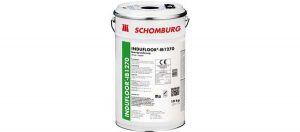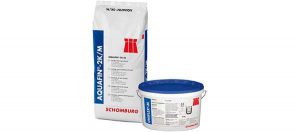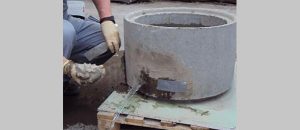SANIFLEX Art.-No. 2 05004
Liquid waterproof membrane for use beneath tiles
• ready-to-use
• very low emissions
• solvent-free
•brush, roller or trowel applied
• vapour permeable
• fast drying
•elastic and impermeable to water
• for interior use
Areas of application:
Seamless and jointless waterproofing beneath tiles in wet duty areas where impermeability to water is required such as e.g. in domestic bathrooms and kitchens, private and commercial washrooms. SANIFLEX is suitable for walls in wet duty class A in accordance with general technical test criteria and wet duty class A0 in accordance with the ZDB data sheet “Bonded waterproof membranes”. Reinforce wall/floor junctions by incorporating ASO-Joint-Tape-2000 or ASO-Joint-Tape-Standard into the elastic waterproof membrane. SANIFLEX is suitable for use in interior rooms in
accordance with the AgBB evaluation scheme (Committee for Health-related Evaluation of Building Products) and the French VOC by-law. Very low emissions
in accordance with GEV-EMICODE, which as a rule leads to positive evaluation within the scope of building certification systems in accordance with DGNB, LEED, BREEAM, HQE. Highest quality level 4, rows 2,3,9 in accordance with the DGNB criterion “ENV 1.2 Local environmental impact“.
Technical Data:
Basis: solvent free polymer dispersion with carbonate fillers
Packaging: · ۵, ۱۲ and 20 kg packs in the colour ochre · ۲۰ kg packs in the colour grey
article number: 205004900
Colour: ochre and grey
Density: approx. 1.4 g/cm3
Pot life*): approx. 60 mins
Application
substrate temp: +5 °C to +30 °C Reaction to fire according to DIN EN13501-1: E Crack-bridging based on DIN 28052-6, 0.4 mm crack, maintained 24
hours: passed
Sd value: approx. 2 m
Testing: General technical certificate for liquid applied waterproofing materials in combination with tiles, Bautest Dresden GmbH P-2002-4-1023/03 Emissions testing to AgBB scheme, GEV-test method, French and Belgian VOC by-law CSTB tested (Avis Techniques 13/13-1197) Material consumption / minimum dry film
thickness: 1.2 kg/m2/approx. 0.5 mm dry film thickness, greater material consumption on uneven substrates is not taken into account.
Ready for use : foot traffic after approx. 1 day, ready to install tiles after approx. 1 day at +20 °C and 60 % relative humidity
Storage: frost free, 15 months in the original unopened containers. Use opened packaging promptly.
Cleaning: Clean tools with water whilst product is still fresh. Soften dried on material with ASO-R003 and wash off.
Substrate preparation:
All flat, load-bearing surfaces, which can take tiles and bonded waterproof membranes are suitable. Furthermore the suitability of the substrate in the appropriate wet duty class must be given (refer to ZDB data sheet [*1]). The substrate must be load-bearing, adequately flat to DIN 18202, free from penetrating cracks and be free from separating substances such as e.g. oil, paint, laitance layers and loose areas. The substrate must have a largely closed surface and exhibit a surface condition and strength commensurate with its type. DIN 18157, part 1 is mandatory for substrate, substrate preparation and product application. Separating cracks are to be technically noted and as necessary adhesively sealed beforehand e.g. with ASODUR-K900.
Plasters/renders to DIN EN 998-1, of strength classes CS I to CS IV must have a minimum compressive strength of 2.5 N/mm2 and be suitable for installing tiles in the relevant wet duty class. Prime absorbent and insignificantly sanded substrates with ASO-Unigrund-GE, ASO-Unigrund-S or ASO-Unigrund-K (mix ratio 1:3 with water). Exclude height differences in the substrate to be laid over and prevent moisture penetration from behind. Level out irregularities appropriately before using SANIFLEX. Levelling can be carried out e.g. with the levelling compounds SOLOPLAN-30-PLUS, SOLOCRET-50 or SOLOCRET-15.
In areas exposed to moisture, incorporate a fall of at least 1.5% in the direction of the drain. Floor drains should have a thin-bed flange of minimum circumferential width of 5 cm and consist of a material suitable for bonding such as e.g. stainless steel, brass, PVC-U. Before tiling heated screeds, they must be commissioned in accordance with recognized technical regulations. Carry out moisture measurements with a carbide hygrometer (CM device) to determine the readiness of a substrate to receive finishes. Moisture measurements may not exceed
• CT ≤ ۲.۰ CM% for screeds on insulation or separating layers
• Calcium sulphate screeds without underfloor heating ≤ ۰.۵ CM%
• Calcium sulphate screeds with underfloor heating ≤ ۰.۳ CM%
The carbide hygromter measurement is to be carried out in accordance with current FBH-AD working practice extracted from the technical information
sheet “Coordination of cut-out areas in heated floor construction”. Calcium sulfate screeds can be accepted in privately used bathrooms without a floor drain. They must be abraded, vacuumed and as with all calcium sulfate based substrates primed with ASO-Unigrund-GE, ASO-Unigrund-S or ASO-Unigrund-K (mix ratio 1:3 with water).
Product Preparation:
1. Prime the substrate with ASO-Unigrund-GE, ASO-Unigrund-S or ASO-Unigrund-K (1:3 to 1:4 diluted with water). If a water vapour barrier function is required e.g. in the Scandinavian (timber) construction method, use ASO-Unigrund-D.
2. Once the primer has dried, apply SANIFLEX undiluted with a steel float, brush or a lamb’s wool roller. When trowel applying, an even thickness is achieved by using a 4 mm notched trowel and subsequently smoothening. Overcoat any voids. A wet film thickness of 1 mm achieves a dry film thickness of approx. 0.6 mm. In wet duty class A, at least two coats are required when brush or roller applying. The previous coat must have dried out before the second coat is applied.
3. For the formation of impermeable movement and connecting joints, insert the system components from the ASO-Joint-Tape technology appropriate for the
particular wet duty class. Coat both sides of the joint to be bridged with SANIFLEX to at least 2 cm wider than the joint tape, with a 4–۶ mm notched trowel. Lay the joint tape into the wet coat and then carefully press into the waterproofing layer with a steel trowel or hard roller, without voids are folds. Ensure that, as far as possible full bedding and full contact is achieved. Bond in such a way as to exclude water migration around
the back of the joint tape and pre-formed pieces. Lay the joint tape in a loop over the movement joint. Overlap joint tape ends by a minimum of 5 to 10 cm, bond with SANIFLEX without folds and with a full bed, overcoat and incorporate seamlessly into the surface applied membrane. Insert pre-formed pieces following the same method. Use the named joint tapes and preformed strips as system components.
4. Installation of tiles is carried out with one of the named adhesives from the system components. At the time of tiling, the waterproof coat must have hardened.
5. Do not expose SANIFLEX to water until cured. In this context, bonded overlapped areas of joint tape/ pre-formed pieces will take considerably longer to dry
dependent on ambient conditions.
Important advice:
• Protect areas not be treated with SANIFLEX.
• Polymer dispersions can only dry out if the temperature of the substrate is at least +3°C above the dew point of the air in the room and there is also air movement. Therefore in rooms with high humidity, plan for longer drying times. If there is a risk of dropping below the dew point (condensation forming), introduce dehumidifiers until the waterproof membrane has cured.
• Observe the appropriate relevant technical data sheet for the named products.
• Follow relevant current regulations. For e.g.
DIN 18157
DIN 18352
DIN 18560
EN 13813
DIN 1055
The BEB information sheets distributed by Bundesverband Estrich und Belad e.V. The technical information “Coordination of cut-out areas in heated floor construction” The ZDB information sheets distributed by the
Fachverband des deutschen Fliesenegwerbes:
[*1] „Bonded waterproof membranes”
[*۳] „Movement joints in ceramic wall and floor tile finishes”
[*۵] „Ceramic tiles and slabs, natural stone and cement bound composite slabs on cement-based floor constructions with insulation.”
[*۶] „Ceramic tiles and slabs, natural stone and cement bound composite slabs on heated cementbased floor constructions.”
Please observe a current valid EU Safety data sheet.
GISCODE: D1




